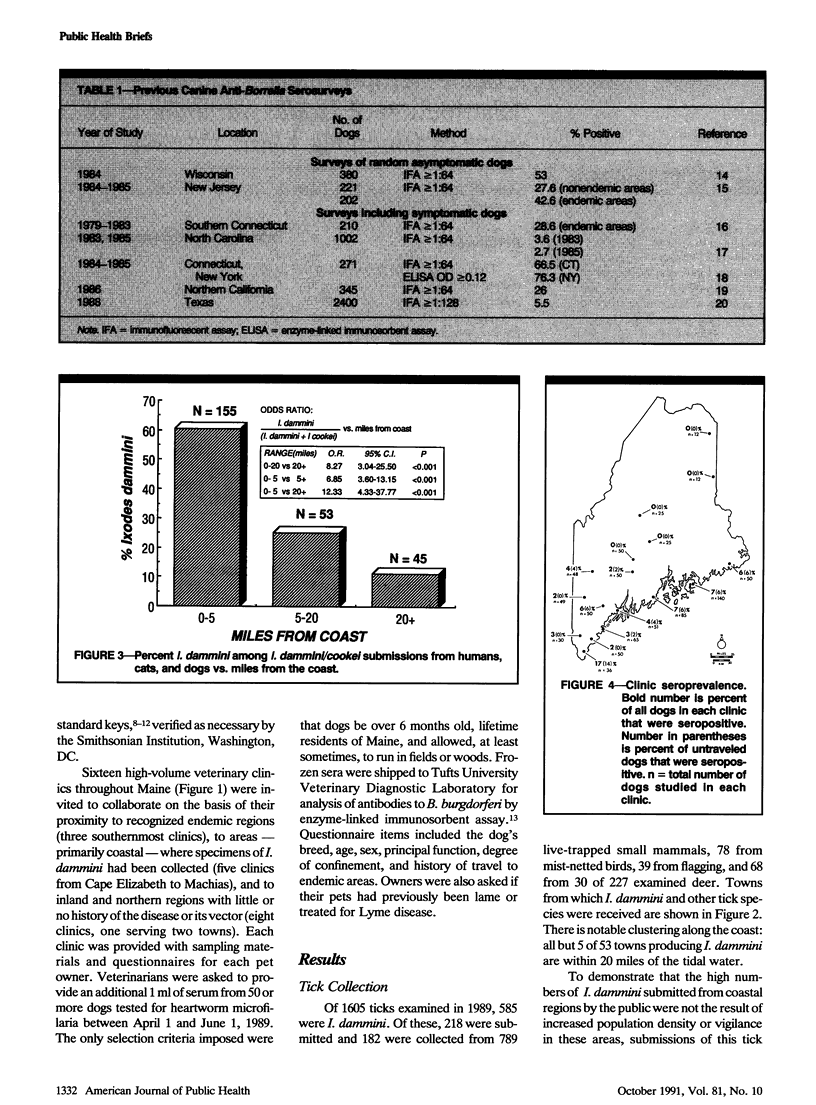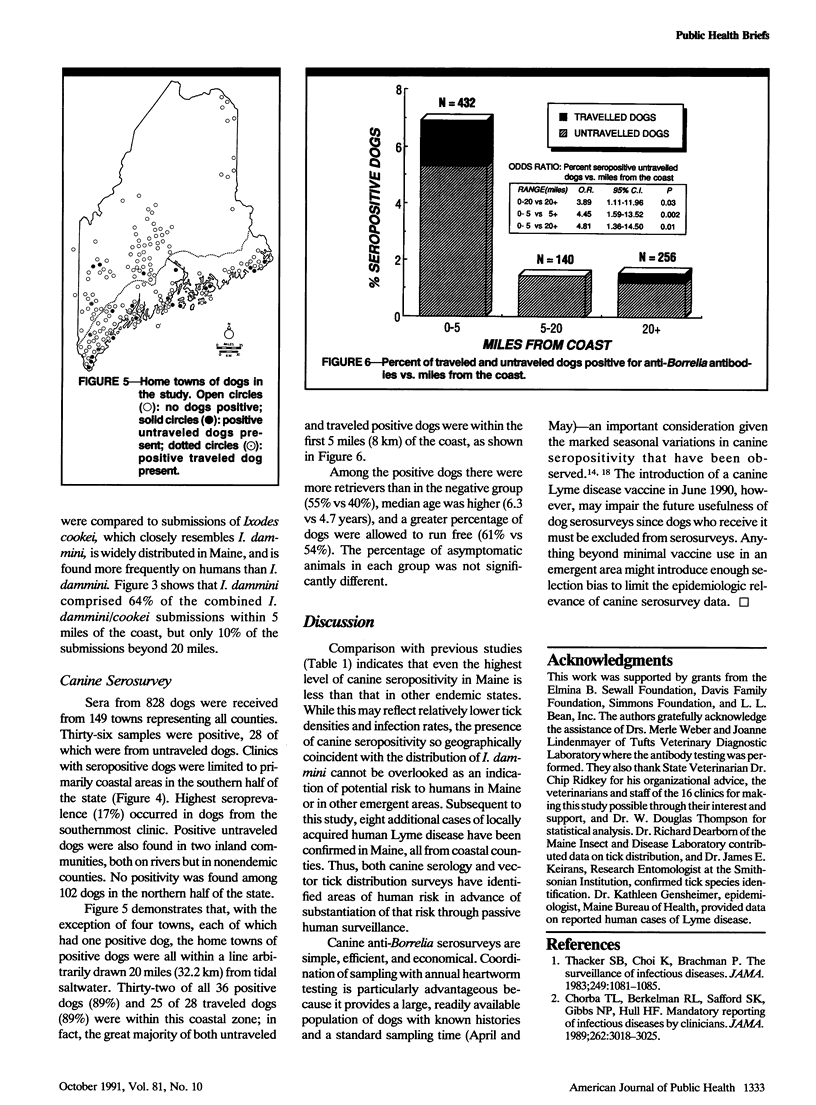Abstract
This study evaluates the relative usefulness of canine serosurveys to predict risk of exposure in an area of emerging Lyme disease by comparing the distribution of canine seroprevalence with that of vector ticks. From 16 veterinary clinics throughout the State of Maine, 828 canine sera were obtained during the heartworm-testing months of April and May 1989 and measured for anti-Borrelia antibodies by enzyme-linked immunosorbent assay. In the same year, 1605 ticks, including 585 Ixodes dammini, were collected from pets, humans, small mammals, and deer. Thirty-six dogs were seropositive, 28 of which had not traveled to endemic areas. Eighty-nine percent of all seropositive dogs were from towns within 20 miles (32 km) of the coast; the great majority lived within 5 miles (8 km) of tidewater (odds ratio =4.45, P = .002). Positivity varied from 17% in a southern coastal clinic to 0% in four northern clinics. Of 585 I. dammini identified, all but 5 (99.1%) were also from towns within 20 miles of the coast. Comparison of I. dammini submissions with those of another commonly found tick, Ixodes cookei, corroborated this predominantly coastal distribution. Canine seropositivity generally coincided with this coastal range. These data predicted areas of risk for human Lyme disease, although the prevalence of reported cases remained low.
Full text
PDF



Selected References
These references are in PubMed. This may not be the complete list of references from this article.
- Anderson J. F., Magnarelli L. A., McAninch J. B. Ixodes dammini and Borrelia burgdorferi in northern New England and upstate New York. J Parasitol. 1987 Apr;73(2):419–421. [PubMed] [Google Scholar]
- Burgess E. C. Natural exposure of Wisconsin dogs to the Lyme disease spirochete (Borrelia burgdorferi). Lab Anim Sci. 1986 Jun;36(3):288–290. [PubMed] [Google Scholar]
- Chorba T. L., Berkelman R. L., Safford S. K., Gibbs N. P., Hull H. F. Mandatory reporting of infectious diseases by clinicians. JAMA. 1989 Dec 1;262(21):3018–3026. [PubMed] [Google Scholar]
- Cohen N. D., Carter C. N., Thomas M. A., Jr, Angulo A. B., Eugster A. K. Clinical and epizootiologic characteristics of dogs seropositive for Borrelia burgdorferi in Texas: 110 cases (1988). J Am Vet Med Assoc. 1990 Oct 1;197(7):893–898. [PubMed] [Google Scholar]
- Eng T. R., Wilson M. L., Spielman A., Lastavica C. C. Greater risk of Borrelia burgdorferi infection in dogs than in people. J Infect Dis. 1988 Dec;158(6):1410–1411. doi: 10.1093/infdis/158.6.1410. [DOI] [PubMed] [Google Scholar]
- Greene R. T., Levine J. F., Breitschwerdt E. B., Berkhoff H. A. Antibodies to Borrelia burgdorferi in dogs in North Carolina. Am J Vet Res. 1988 Apr;49(4):473–476. [PubMed] [Google Scholar]
- Hedberg C. W., Osterholm M. T., MacDonald K. L., White K. E. An interlaboratory study of antibody to Borrelia burgdorferi. J Infect Dis. 1987 Jun;155(6):1325–1327. doi: 10.1093/infdis/155.6.1325. [DOI] [PubMed] [Google Scholar]
- Keirans J. E., Clifford C. M. The genus Ixodes in the United States: a scanning electron microscope study and key to the adults. J Med Entomol Suppl. 1978 Jul 20;2:1–149. doi: 10.1093/jmedent/15.suppl2.1. [DOI] [PubMed] [Google Scholar]
- Keirans J. E., Litwak T. R. Pictorial key to the adults of hard ticks, family Ixodidae (Ixodida: Ixodoidea), east of the Mississippi River. J Med Entomol. 1989 Sep;26(5):435–448. doi: 10.1093/jmedent/26.5.435. [DOI] [PubMed] [Google Scholar]
- Lastavica C. C., Wilson M. L., Berardi V. P., Spielman A., Deblinger R. D. Rapid emergence of a focal epidemic of Lyme disease in coastal Massachusetts. N Engl J Med. 1989 Jan 19;320(3):133–137. doi: 10.1056/NEJM198901193200301. [DOI] [PubMed] [Google Scholar]
- Lindenmayer J., Weber M., Bryant J., Marquez E., Onderdonk A. Comparison of indirect immunofluorescent-antibody assay, enzyme-linked immunosorbent assay, and Western immunoblot for the diagnosis of Lyme disease in dogs. J Clin Microbiol. 1990 Jan;28(1):92–96. doi: 10.1128/jcm.28.1.92-96.1990. [DOI] [PMC free article] [PubMed] [Google Scholar]
- Magnarelli L. A., Anderson J. F., Kaufmann A. F., Lieberman L. L., Whitney G. D. Borreliosis in dogs from southern Connecticut. J Am Vet Med Assoc. 1985 May 1;186(9):955–959. [PubMed] [Google Scholar]
- Magnarelli L. A., Anderson J. F., Schreier A. B., Ficke C. M. Clinical and serologic studies of canine borreliosis. J Am Vet Med Assoc. 1987 Nov 1;191(9):1089–1094. [PubMed] [Google Scholar]
- Magnarelli L. A. Serologic diagnosis of Lyme disease. Ann N Y Acad Sci. 1988;539:154–161. doi: 10.1111/j.1749-6632.1988.tb31848.x. [DOI] [PubMed] [Google Scholar]
- Schulze T. L., Bosler E. M., Shisler J. K., Ware I. C., Lakat M. F., Parkin W. E. Prevalence of canine Lyme disease from an endemic area as determined by serosurvey. Zentralbl Bakteriol Mikrobiol Hyg A. 1987 Feb;263(3):427–434. doi: 10.1016/s0176-6724(87)80104-9. [DOI] [PubMed] [Google Scholar]
- Spielman A., Clifford C. M., Piesman J., Corwin M. D. Human babesiosis on Nantucket Island, USA: description of the vector, Ixodes (Ixodes) dammini, n. sp. (Acarina: Ixodidae). J Med Entomol. 1979 Mar 23;15(3):218–234. doi: 10.1093/jmedent/15.3.218. [DOI] [PubMed] [Google Scholar]


